Boulogne-sur-Mer Passenger Lists 1892-1939
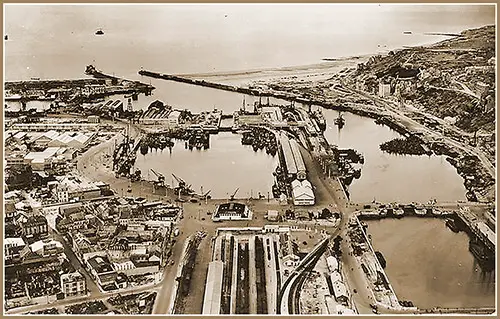
View of the Port of Boulogne-sur-Mer, circa 1950. GGA Image ID # 1754869a4d
Boulogne-sur-Mer is a city in northern France. Boulogne lies on the Côte d'Opale, a touristic coast on the English Channel, and is the most-visited location in its region after the Lille conurbation.
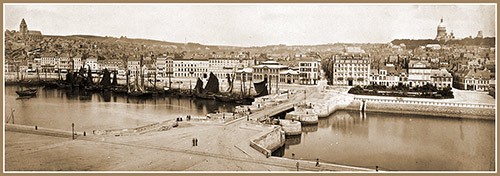
Panorama of Boulogne-sur-Mer, Northern France, ca 1910. GGA Image ID # 1d4b473c22
Port of Boulogne-Sur-Mer, France
(Latitude, 50° 44/ N., longitude Io 35' E. Population, 55,336.)
Pilotage.—Compulsory for ull vessels. Captain of the port at Bureau du Port. Fees for steamers in or out are 3 cents per register ton. Pilot boats cruise off the port. To call pilot, hoist a blue flag with a white border, or lacking this, national ensign. At night, white light above nettings obscures it at 15-second intervals for one minute. Signal stations at Cape Gris Nez and Cape d'Alprech.
Salutes.—It is not a saluting port.
Wireless.—There is a Government wireless station—Belline-Tosi system. Open to the public. Call letters FFB; one of 5 kilowatts and one of 1 kilowatt. Wavelength 600 meters for one and 300 meters for other.
Officials and courtesies.—It is not a military port.
Civil: Sous-préfet and the mayor; should receive the first call from the commander of a visiting man-of-war. United States vice consul.
Naval: The administrateur principal de l'inscription maritime: rank changes.
Military: The commandant; rank changes.
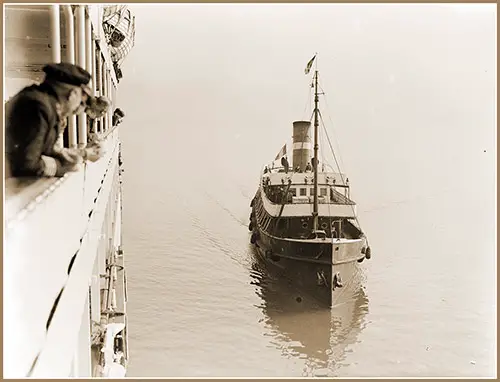
A Tender Approaches an Ocean Liner at the French Port of Boulogne-sur-Mer, 1934. GGA Image ID # 1d4ba0144a
Quarantine regulations.—Same as for other French ports (see St. Nazaire). Bill of health not required from men-of-war, but an1 issued by agent Sanitaire, Capitaine de douanes.
Anchorages.—If warships should visit the port, they would probably have to anchor in the outer harbor. If space were available, a berth alongside the quay would be assigned.
Regulations for ashes and garbage.—Dumping is forbidden. For this, one should put ashes in sacks and waste in closed metal barrels. No lighters. If alongside the quay, they would be removed by the city's carts.
Boat landings.—For the outer anchorage, near the entrance to the dock. Any place or quay available. Good at all tides but poorly lighted at night.
Shore boats.—No shore boats.
Shore leave.—Facilities good for small liberty parties. The Captain of the ship should obtain permission from the mayor. Three hours from Paris.
Patrols. It should be arranged with the commandant d'armes.
Swimming, bathing, and athletics.—Not allowed in the inner harbor. There are several public bathing beaches'; bathing costumes are required. There are tennis courts and holds where sports could be held.
Shore drills and target practice.—No facilities.
Facilities for fresh water.—Water for steaming and drinking is obtainable from hydrants at the quays. There are no water boats.
Coaling facilities.—About 10,000 tons of English and French coal are usually on hand. Many tugs are available. No fuel oil or gasoline.
Ship's Supplies.—All kinds of supplies obtainable. Plentiful if only a few foreign ships come at a time. No bumboats.
Docking and repairing facilities.—The Chambre de Commerce has three gridirons; one 416 feet long, with 15 1/2 feet at high water; one 140 feet long, with 16 1/3 feet at high water; and one 62 feet long, with 15 1/2 feet at high water.
Baheaux Freres has a slipway 213 feet long, from 7 1/2 to 15 feet at high water, a capacity of 1,000 tons, and repairs hulls and machinery. A floating dock, 236 1/6 by 62 1/2 feet, can take ships of 1,300 tons, drawing 16.4 feet. There is also an ex-German floating dry dock, 405 feet by 92 1/3 feet.
Port regulations.—There is no restriction on the number of men-of-war that may enter the port or the length of stay other than the general French regulations. Entering at night depends on tide and advance notice.
Sanitation and hospitals.—Sanitation is good. Three hospitals; equipment and sanitation good.
No cables. Mail and steamship facilities.
It is well to remember that only vessels of very small tonnage can enter the port and that the outer harbor, where ships of greater tonnage must anchor, is not protected from the north winds, the only protection being afforded by a sea wall to the south.
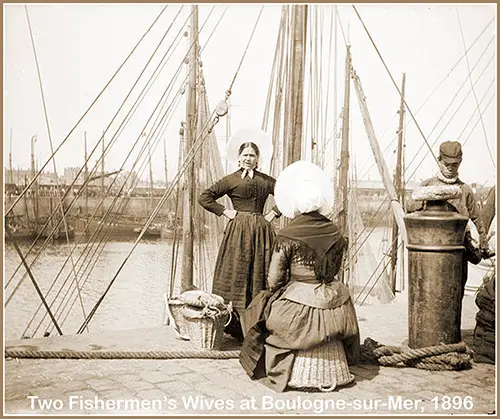
Boulogne-sur-Mer Two Fishermen's Wives on the Pier, 17 August 1896. Photo by René Desclée. GGA Image ID # 1d4b8a2c96
Passenger Lists for Ships Calling at the Port of Boulogne-sur-Mer, France
Note: Typically, only the origination and final destination ports are listed in each link. Other intermediary ports of call are not listed.
1890s
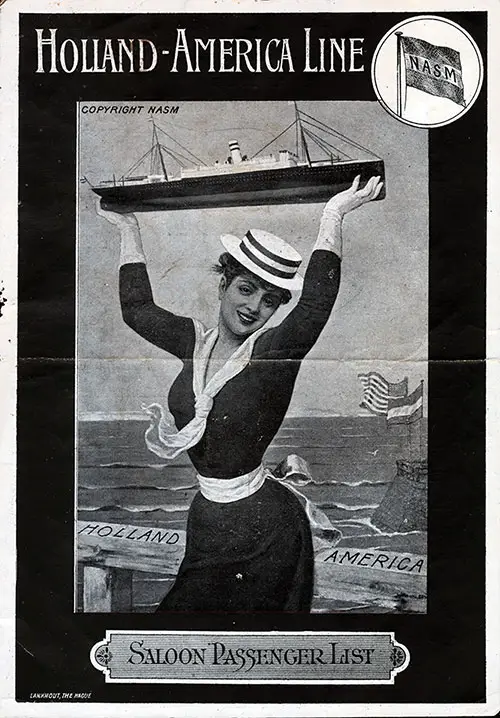
Holland-America Line
1900s

Hamburg American Line / Hamburg Amerika Linie (HAPAG)
- 1900-10-07 SS Patricia - Hamburg to New York
- 1901-07-28 SS Pretoria - Hamburg to New York
- 1902-06-21 SS Pennsylvania - Hamburg to New York
- 1903-08-22 SS Pretoria - Hamburg to New York
- 1904-06-28 TSS Ryndam - New York to Rotterdam
- 1905-09-14 SS Hamburg - Hamburg to New York
- 1905-11-11 SS Pennsylvania - Hamburg to New York
- 1906-08-04 SS Pennsylvania - Hamburg to New York
- 1909-09-20 SS Koning Wilhelm II - Boulogne-sur-Mer to Rio de Janeiro and La Plata

Holland-America Line
- 1904-02-02 SS Rotterdam - New York to Rotterdam
- 1904-07-02 TSS Potsdam - Rotterdam to New York
- 1904-09-24 TSS Rotterdam - Rotterdam to New York
- 1905-07-29 SS Graf Waldersee - Hamburg to New York
- 1908-06-20 TSS Nieuw Amsterdam - Rotterdam to New York
- 1908-07-25 TSS Rotterdam - Rotterdam to New York
- 1908-08-15 TSS Statendam - Rotterdam to New York
- 1908-09-12 TSS Ryndam - Rotterdam to New York
- 1908-09-19 TSS Statendam - Rotterdam to New York
- 1909-09-18 TSS Potsdam - Rotterdam to New York
1910s

Hamburg American Line / Hamburg Amerika Linie (HAPAG)
Holland-America Line
- 1910-08-27 TSS Rotterdam - Rotterdam to New York
- 1910-09-17 TSS Nieuw Amsterdam - Rotterdam to New York
- 1910-12-17 TSS Ryndam - Rotterdam to New York
- 1911-05-13 TSS Ryndam - Rotterdam to New York
- 1912-06-18 TSS Noordam - New York to Rotterdam
- 1912-08-31 TSS Rotterdam - Rotterdam to New York
- 1913-04-05 TSS Rotterdam - Rotterdam to New York
- 1913-08-02 TSS Potsdam - Rotterdam to New York
1920s

Atlantic Transport Line
- 1925-07-11 SS Minnekahda - London to New York
- 1925-08-08 SS Minnekahda - London to New York
- 1927-04-23 SS Minnewaska - London to New York
- 1927-06-11 SS Minnesota - New York to London
- 1927-08-20 SS Minnesota - London to New York
- 1927-09-03 SS Minnekahda - London to New York
- 1927-10-15 SS Minnesota - London to New York
- 1927-12-17 SS Minnetonka - Tilbury (London) to New York
- 1928-03-31 SS Minnekahda - London to New York
- 1928-06-23 SS Minnekahda - London to New York
- 1928-07-07 SS Minnesota - London to New York
- 1928-07-21 SS Minnekahda - London to New York
- 1928-08-04 SS Minnesota - London to New York
- 1928-08-25 SS Minnewaska - London to New York
- 1929-10-12 SS Minnewaska - Tilbury (London) to New York

Hamburg American Line / Hamburg Amerika Linie (HAPAG)
- 1926-01-28 SS Albert Ballin - Hamburg to New York
- 1926-07-30 SS Deutschland - Hamburg to New York
- 1926-08-27 SS Albert Ballin - Hamburg to New York
- 1926-12-10 SS Cleveland - Hamburg to New York
- 1927-08-12 SS Deutschland - Hamburg to New York
- 1927-09-23 SS Deutschland - Hamburg to New York
- 1928-10-12 SS Deutschland - Hamburg to New York
- 1929-01-16 SS New York - Hamburg to New York
- 1929-03-15 SS Hamburg - Hamburg to New York
- 1929-04-05 SS New York - Hamburg to New York
- 1929-10-17 SS Cleveland - Hamburg to Boston and New York

Holland-America Line
- 1920-10-19 TSS Rotterdam - Rotterdam to New York
- 1921-02-12 TSS Rotterdam - Rotterdam to New York
- 1921-06-04 TSS Nieuw Amsterdam - New York to Rotterdam
- 1921-06-08 TSS Rotterdam - Rotterdam to New York
- 1921-07-12 TSS Rotterdam - Rotterdam to New York
- 1921-08-17 TSS Rotterdam - Rotterdam to New York
- 1922-07-22 TSS Rotterdam - New York to Rotterdam
- 1922-10-17 TSS Rotterdam - Rotterdam to New York
- 1923-05-23 TSS Veendam - Rotterdam to New York
- 1924-04-15 TSS Rotterdam - Rotterdam to Halifax and New York
- 1924-05-21 TSS Rotterdam - Rotterdam to Halifax and New York
- 1924-11-12 TSS Rotterdam - Rotterdam to New York
- 1925-09-02 TSS Rotterdam - Rotterdam to New York
- 1926-07-20 TSS Rotterdam - Rotterdam to New York
- 1926-08-03 TSS Veendam - Rotterdam to New York
- 1926-08-25 TSS Rotterdam - Rotterdam to New York
- 1928-06-16 TSS Veendam - New York to Rotterdam
- 1928-08-07 TSS Veendam - Rotterdam to Halifax and New York
- 1929-05-29 TSS Rotterdam - Rotterdam to New York
- 1929-06-15 TSS Rotterdam - New York to Rotterdam
- 1929-08-13 TSS Nieuw Amsterdam - Rotterdam to Halifax and New York
- 1929-08-23 TSS Statendam - Rotterdam to New York
- 1929-09-04 TSS Volendam - Rotterdam to New York
- 1929-09-11 TSS Rotterdam - Rotterdam to New York
North German Lloyd / Norddeutscher Lloyd
Red Star Line
United American Lines (Harriman Line)
1930s

Atlantic Transport Line
Hamburg America Line / Hamburg-Amerika Linie (HAPAG)
Holland-America Line
- 1930-06-28 TSS Rotterdam - New York to Rotterdam
- 1930-07-04 SS Statendam - Rotterdam to New York
- 1930-07-26 TSS Nieuw Amsterdam - Rotterdam to New York
- 1930-08-09 TSS Rotterdam - Rotterdam to New York
- 1930-09-27 TSS Statendam - Rotterdam to New York
- 1931-10-09 TSS Rotterdam - Rotterdam to New York
- 1932-08-26 TSS Statendam - Rotterdam to New York
- 1933-09-02 TSS Rotterdam - Rotterdam to New York
- 1934-05-26 TSS Rotterdam - Rotterdam to New York
- 1934-06-29 SS Statendam - New York to Rotterdam
- 1934-08-25 TSS Statendam - Rotterdam to New York
- 1934-10-06 TSS Statendam - Rotterdam to New York
- 1935-07-13 TSS Veendam - New York to Rotterdam
- 1936-08-06 TSS Statendam - Rotterdam to New York
- 1937-07-10 TSS Statendam - Rotterdam to New York
- 1937-07-24 TSS Veendam - Rotterdam to Boston and New York
- 1937-08-06 TSS Statendam - Rotterdam to Boston and New York
- 1937-08-11 TSS Rotterdam - Rotterdam to New York
- 1937-09-04 TSS Veendam - Rotterdam to New York
- 1938-08-20 TSS Statendam - Rotterdam to New York
- 1938-08-27 TSS Nieuw Amsterdam - Rotterdam to New York
- 1938-10-01 TSS Statendam - Rotterdam to New York
- 1939-09-09 SS Volendam - Antwerp to New York
North German Lloyd / Norddeutscher Lloyd
Royal Mail Lines
The Importance of the Port of Boulogne-sur-Mer
The seaport of Boulogne, on the British Channel, has rendered outstanding service during the war. It is chiefly important for two things passenger traffic and fish. The port is advantageously located between Paris and London. Before the war, passenger trains made the trip between Boulogne and Parts In 2 hours and 45 minutes.
The passenger steamers cross the channel between Boulogne and Folkestone ln 1 hour and 15 minutes, and between Folkestone and Victoria Station. London, the journey is covered in about 2 hours.
Due to this excellent train and steamship service, carrying a steady stream of passengers between the two great European capitals, Boulogne has been able to claim the first passenger port position in France. Like a number of the channel ports, this port anticipates the possibility of some diversion of passenger traffic between England and France in the not distant future because of the construction of a tunnel connecting the two countries.
Boulogne, The Pride of Picardy
To distinguish it from the suburb of Paris on the Seine, Boulogne is generally called Boulogne-sur-Mer. And it is that. More probably than any of the larger ports of France is Boulogne on the open sea.
It has no outer harbor, protected by islands or curves in the coast, and ships do not have to wind a tortuous way through artificial channels into basins hidden in the town. The channel opens directly into the sea.
Its entrance is protected on each side by breakwaters, with a lighthouse at the end. If one comes by liner, the anchor is cast inside the enormous Digue Carnot, which serves the double purpose of dike and quay.
The railroad runs out on it, and there is room for handling freight. From the steamer's deck, one can see that barriers wholly protect the outer port and basins. You do not feel like going inland and are not shut off from the sea by promontories or cliffs.
Boulogne the great seaport is still of the future. Boulogne is cut in two by the old rectangular tidal port (the fishing vessels and the Channel steamers), the arrière-port with its locks and bridges, and the Liane River. But although the statistics given you locally throw in the fishing,
Boulogne's present importance as a commercial port is relatively slight. The southern and eastern half of the town is mainly given up to basins and shipping.
Here are the Gare Maritime and the central railway station, the tracks and covered warehouses for freight movement, the yards for building and repairing ships, the arsenal, and the casem. Because of the tonnage entering and leaving the port, Boulogne disputes Dunkirk's claim to be the fourth port in France.
So we leave steamers and railways for the right bank of the Liane and the Boulogne that never tires us.
Related Categories
Ephemera & History
- Atlantic Transport Line
- Hamburg American Line
- Holland-America Line
- North German Lloyd
- Red Star Line
- Royal Mail Lines
- United American Lines (Harriman Line)
Steamship & Ocean Liners
- Albert Ballin
- Asturias
- Belgenland
- Bremen
- Cleveland
- Deutschland
- Graf Waldersee
- Hamburg
- Karlsruhe
- Koning Wilhelm II
- Milwaukee
- Minnekahda
- Minnesota
- Minnetonka
- Minnewaska
- New York
- Nieuw Amsterdam
- Noordam
- Patricia
- Pennland
- Pennsylvania
- Potsdam
- President Lincoln
- Pretoria
- Rotterdam
- Ryndam
- Spaarndam
- Statendam
- Stuttgart
- Veendam
- Volendam
Ports of Call Information
SS RMS MV - Defined
PLs By Year of Voyage
- 1899
- 1900
- 1901
- 1902
- 1903
- 1904
- 1905
- 1906
- 1908
- 1909
- 1910
- 1911
- 1912
- 1913
- 1920
- 1921
- 1922
- 1923
- 1924
- 1925
- 1926
- 1927
- 1928
- 1929
- 1930
- 1931
- 1932
- 1933
- 1934
- 1935
- 1936
- 1937
- 1938
- 1939
PLs By Port of Call
- Antwerp
- Boston
- Boulogne-sur-Mer
- Bremen
- Buenos Aires
- Halifax
- Hamburg
- La Plata
- London
- New York
- Rio de Janeiro
- Rotterdam
- Southampton
PLs By Region
PLs By Steamship Line
Navy Department, US Office of Naval Intelligence, "Boulogne-sur-Mer, France," in Port Directory of Principal Foreign Ports, Third Ed., Washington, DC: US Government Printing Office, 1923, pp. 216-217.
Herbert Adams Gibbons, "Chapter III: Boulogne, The Pride of Picardy," in Ports of France, New York-London: The Century Company, 1926, pp. 33-35
